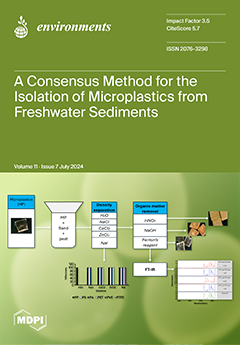Rural and semi-urban areas in arid/semi-arid regions are facing severe water scarcity and a series of environmental challenges nowadays, specifically due to rapid urbanization and economic development, climate change, population growth, increasing water demand, influxes of refugees caused by war and regional political
[...] Read more.
Rural and semi-urban areas in arid/semi-arid regions are facing severe water scarcity and a series of environmental challenges nowadays, specifically due to rapid urbanization and economic development, climate change, population growth, increasing water demand, influxes of refugees caused by war and regional political conflict, etc. To solve the emerging problems, the safe reuse of treated wastewater in agriculture can provide an additional water resource for countries with high water scarcity. The aim of this study was to investigate the treatment performance and effectiveness of small decentralized wastewater treatment (DWWT) technologies treating high-strength wastewater with concentrations far beyond the European Union testing ranges of parameters such as five-day biochemical oxygen demand (BOD
5 > 500 mg/L), chemical oxygen demand (COD > 1000 mg/L), or total suspended solids (TSS > 700 mg/L). Four (4) commercially available DWWT technologies with a design capacity of 4–8 PE (population equivalent) were selected and operated with various wastewater compositions in Leipzig, Germany. The technologies were (i) the moving bed biofilm reactor (MBBR), (ii) the sequencing batch reactor (SBR), (iii) the membrane bioreactor (MBR) and (iv) the aerated vertical-flow constructed wetland (AVFCW). This study results clearly demonstrated that the EU-certified small DWWT technologies are quite capable of treating high-strength wastewater and can provide high-quality treated water for safe reuse in rural communities of arid and semi-arid regions. During operation with high-strength wastewater with a mean inflow BOD
5, COD and TSS concentrations of 1532 ± 478, 2547 ± 830 and 546 ± 176 mg/L, a low mean BOD
5 (<10 mg/L), COD (<70 mg/L) and TSS (<15 mg/L) in the outflow of the four systems showed removal efficiency of BOD
5 (>99%), COD (>97%) and TSS (>97%), and met the maximum allowable limit value of water quality class A for reuse in agriculture according to Jordanian and Omani standard. The MBR showed almost a complete removal of
Escherichia coli (
E. coli) in a range of 6.1–6.9-log removal in the outflow during all three experimental phases and performed best for BOD
5, COD, TSS and pathogen removal when treating high-strength wastewater if properly maintained to prevent potential fouling and clogging of the membrane. Before the final permitting process, long-term monitoring under local temperature and climatic conditions as well as guidelines based on local needs (e.g., in Jordan, Oman, etc.) should be developed to guarantee a minimum level of performance standards of such small DWWT technologies and requirements for operation and maintenance (O&M).
Full article





